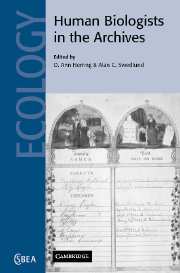 Human Biologists in the Archives
Human Biologists in the Archives Book contents
- Frontmatter
- Contents
- Contributors
- Foreword by Sydel Silverman and Michael A. Little
- Acknowledgements
- 1 Human biologists in the archives: demography, health, nutrition and genetics in historical populations
- 2 The use of archives in the study of microevolution: changing demography and epidemiology in Escazú, Costa Rica
- 3 Anthropometric data and population history
- 4 For everything there is a season: Chumash Indian births, marriages, and deaths at the Alta California missions
- 5 Children of the poor: infant mortality in the Erie County Almshouse during the mid nineteenth century
- 6 Worked to the bone: the biomechanical consequences of ‘labor therapy’ at a nineteenth century asylum
- 7 Monitored growth: anthropometrics and health history records at a private New England middle school, 1935–1960
- 8 Scarlet fever epidemics of the nineteenth century: a case of evolved pathogenic virulence?
- 9 The ecology of a health crisis: Gibraltar and the 1865 cholera epidemic
- 10 War and population composition in Åland, Finland
- 11 Infectious diseases in the historical archives: a modeling approach
- 12 Where were the women?
- 13 Malnutrition among northern peoples of Canada in the 1940s: an ecological and economic disaster
- 14 Archival research in physical anthropology
- Index
- References
1 - Human biologists in the archives: demography, health, nutrition and genetics in historical populations
Published online by Cambridge University Press: 12 August 2009
- Frontmatter
- Contents
- Contributors
- Foreword by Sydel Silverman and Michael A. Little
- Acknowledgements
- 1 Human biologists in the archives: demography, health, nutrition and genetics in historical populations
- 2 The use of archives in the study of microevolution: changing demography and epidemiology in Escazú, Costa Rica
- 3 Anthropometric data and population history
- 4 For everything there is a season: Chumash Indian births, marriages, and deaths at the Alta California missions
- 5 Children of the poor: infant mortality in the Erie County Almshouse during the mid nineteenth century
- 6 Worked to the bone: the biomechanical consequences of ‘labor therapy’ at a nineteenth century asylum
- 7 Monitored growth: anthropometrics and health history records at a private New England middle school, 1935–1960
- 8 Scarlet fever epidemics of the nineteenth century: a case of evolved pathogenic virulence?
- 9 The ecology of a health crisis: Gibraltar and the 1865 cholera epidemic
- 10 War and population composition in Åland, Finland
- 11 Infectious diseases in the historical archives: a modeling approach
- 12 Where were the women?
- 13 Malnutrition among northern peoples of Canada in the 1940s: an ecological and economic disaster
- 14 Archival research in physical anthropology
- Index
- References
Summary
Introduction
A few years ago we began a conversation about how the use of archival data in biological anthropology was changing. Whereas in the past archival research was conducted by a very small number of us (see Foreword, this volume), that number seemed to be growing steadily. In addition, questions, themes, and approaches appeared to be emerging that gave archival research its own character and rationale. Rather than simply being an adjunct, less desirable alternative, or even an afterthought to field or laboratory work, archival research had become the approach of choice for some researchers and some questions. Today, a significant number of physical anthropologists engage in research on populations whose data come primarily from the historical record. In addition, distinctive approaches have emerged from these investigations that can be differentiated from the work of colleagues in, for example, historical demography or the history of medicine (see chapter 14). We also observed that there has been little opportunity to assemble a body of this work or to reflect on its common themes or its contributions to theory and method in physical anthropology. The purpose of this volume is to provide a forum in which researchers who are actively engaged in historical projects present their current research and at the same time more explicitly consider its place in physical anthropological theory and method.
The articles in this volume are new contributions to the physical anthropology literature.
- Type
- Chapter
- Information
- Human Biologists in the ArchivesDemography, Health, Nutrition and Genetics in Historical Populations, pp. 1 - 10Publisher: Cambridge University PressPrint publication year: 2002
References
- 1
- Cited by


